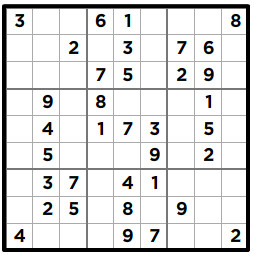

We define a VALID digit as the digit you put in an empty cell so that, We would repeat the definition of valid digit and the valid cell. The only objective at each step is to find a cell in which one and only one digit can be placed. The nine major squares are identified as top left, top middle, top right, left middle, central middle, right middle, bottom left, bottom middle and lastly bottom right.Ī row, a column or a major square each has 9 cells and broadly referred to as a Zone. For example top left corner cell is R1C1 and bottom right corner cell is R9C9.Įach of the 9-cell groups we will call a 9-cell square or a major square.

We will refer to a cell by its row label suffixed with column label. Then only we would say you have successfully completed the game.įor convenience, we will use the labels C1, C2, C3.C9 for identifying the 9 columns and labels R1, R2, R3.R9 for 9 rows. Ultimately your job is to fill up all the empty cells with digits 1 to 9 but without breaking the Sudoku game rule not even once. The whole board has 9 such 9-cell squares with thick borders. You must not repeat any digit in any column, in any row or in any 9-cell medium sized square bordered by thick lines. While filling up any empty cell you must follow the Sudoku game rule: These are the valid digits that you can use to fill up any empty cell. The 81 cell board above is a specific Sudoku game board with some cells filled up with digits from 1 to 9. In today's session we will move a bit faster than before as you have already experienced Sudoku game playing to some extent. The following is the game board we would solve in this session. If you want to skip the brief recap on Sudoku basics and go straight to the solution of game 5, click here. To know the basics of Sudoku in more details please go through the solution of Sudoku for beginners 1 or Sudoku for beginners 2. In this fifth session, with brief recap on Sudoku basics, we will directly take up step by step solution of the Sudoku game that was the exercise in the last session.
#SUPER EASY SUDOKU WITH SOLUTION HOW TO#
The button ( Check / resolvability ) ensures the consistency of the statement without giving the solution of it.Learn how to play beginner Sudoku from step by step easy solution of game 5įirst solve the beginner Sudoku game 5 and then learn how to play beginner Sudoku from step by step easy solution of the game. Then type the number or letter in the appropriate box.įigures in blue are those of the statement and are not modifiable.Move the cursor with the Tab key or with the four arrow keys.Click in one of the numbers of the left column.Select your box by clicking in this one.This page allows you to enter the solution of a 16x16 sudoku grid. We recommend you try Google Chrome, for its speed and its various features are very welcome when it comes to solving puzzles of 256 squares. Indeed the hexadecimal allows easy conversion into binary that uses only two digits: the "0" and the "1". Hexadecimal is particularly used in computer science. Hexadecimal is a system that uses 16 digits: The numbers from 0 to 9 and the letters from "A" to "F". To reduce the size of the grid on the screen and to facilitate entering values, the possibilities are represented here by the following hexadecimal digits: 0, 1, 2, 3, 4, 5, 6, 7, 8, 9, A, B, C, D, E and F. The solving techniques are identical to those of a classic sudoku. A hexadoku is a 16x16 sudoku puzzle instead of 9 x 9 squares.


 0 kommentar(er)
0 kommentar(er)
